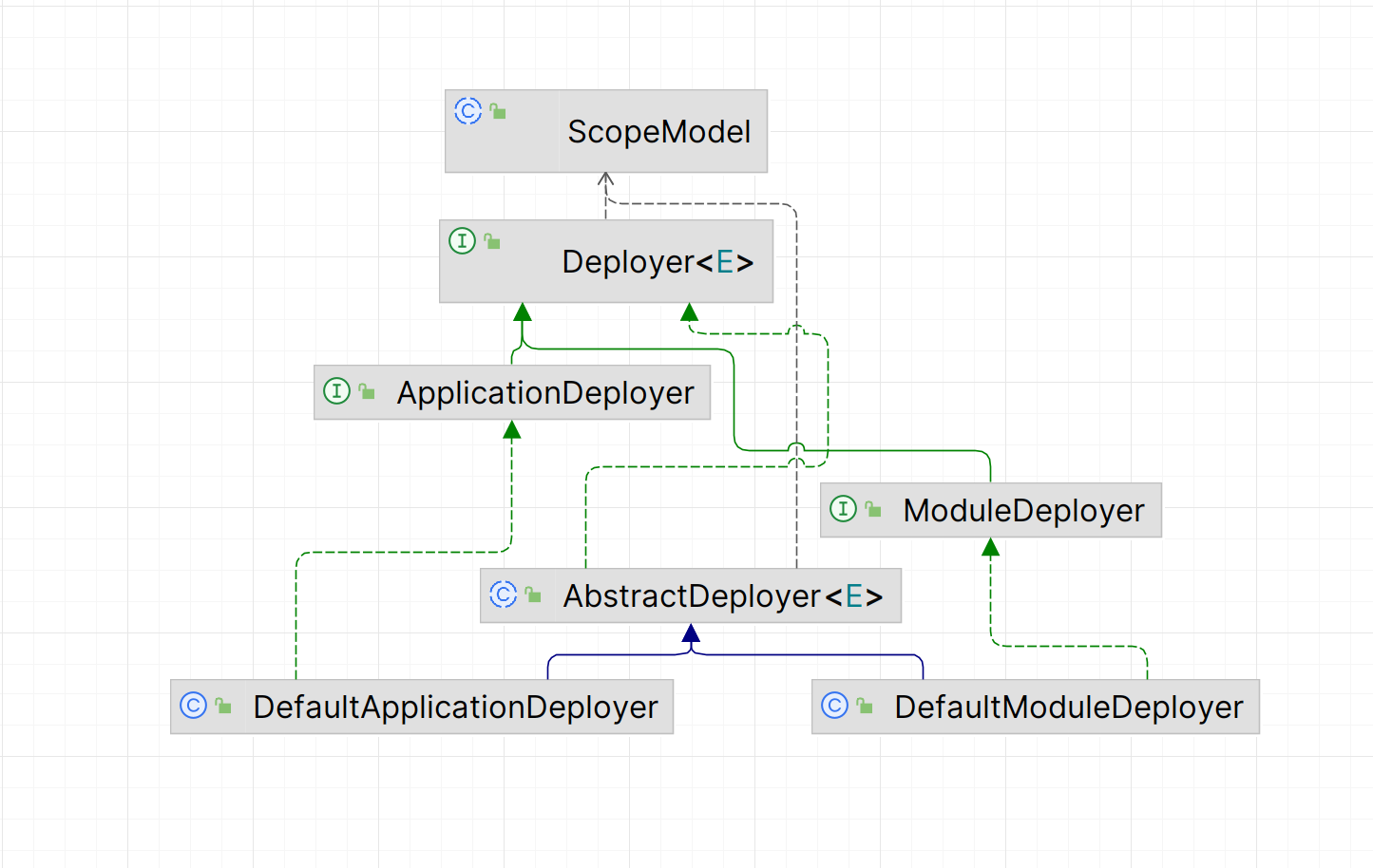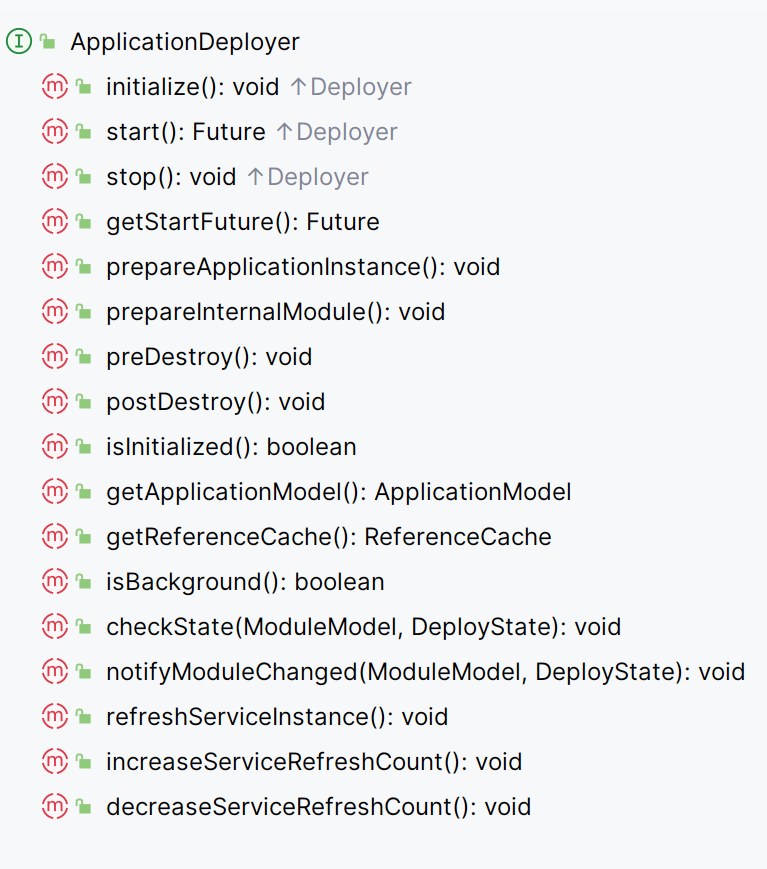Dubbo 3.2版本分析Provider启动时操作
Dubbo 3.2版本分析Provider启动时操作
前言
上一篇文章,我们分析了 Dubbo 3.2 版本在 Provider 启动前的操作流程,这次我们具体分析具体它的启动过程,揭开它的神秘面纱。
例子
这里我们还是以provider启动的Demo为入口,进行分析。如下,为Dubbo服务暴漏出来的接口:
public interface DemoService {
String sayHello(String name);
}
DemoServiceImpl为Dubbo provider
public class DemoServiceImpl implements DemoService {
private static final Logger logger = LoggerFactory.getLogger(DemoServiceImpl.class);
@Override
public String sayHello(String name) {
logger.info("Hello " + name + ", request from consumer: "
+ RpcContext.getServiceContext().getRemoteAddress());
return "Hello " + name + ", response from provider: "
+ RpcContext.getServiceContext().getLocalAddress();
}
}
Application为服务的启动类
public class Application {
private static final String REGISTRY_URL = "zookeeper://sr-1-zk-cluster-1.gz.cvte.cn:2181";
public static void main(String[] args) {
startWithBootstrap();
}
private static void startWithBootstrap() {
ServiceConfig<DemoServiceImpl> service = new ServiceConfig<>();
service.setInterface(DemoService.class);
service.setRef(new DemoServiceImpl());
DubboBootstrap bootstrap = DubboBootstrap.getInstance();
bootstrap
.application(new ApplicationConfig("dubbo-api-provider"))
.registry(new RegistryConfig(REGISTRY_URL))
.protocol(new ProtocolConfig(CommonConstants.DUBBO, -1))
.service(service)
.start()
.await();
}
}
分析
上文分析过设置 application -> 设置 registry -> 设置 protocol -> 设置 serviceConfig 的流程了,这次我们进入 start 方法。
- 进入 start 方法后,最终来到 applicationDeployer.start() 这里。关于 applicationDeployer,它申明是ApplicationDeployer 类型,默认情况下,具体实现为 DefaultApplicationDeployer,关于它们的类结构如图1所示。
- Dubbo 3.0 把服务的发布流程进行了抽象,引入了 **Deployer **的概念,负责应用的的初始化和启动。除了 start 方法,其他方法如图2所示。
public DubboBootstrap start() {
this.start(true);
return this;
}
/**
* Start dubbo application
*
* @param wait If true, wait for startup to complete, or else no waiting.
* @return
*/
public DubboBootstrap start(boolean wait) {
Future future = applicationDeployer.start();
if (wait) {
try {
future.get();
} catch (Exception e) {
throw new IllegalStateException("await dubbo application start finish failure", e);
}
}
return this;
}


- 接着,我们具体看看 DefaultApplicationDeployer对 start 方法的具体实现。
- 这里先进行服务发布状态的判断,通过 AbstractDeployer类里定义的一个共享的成员变量进行判断,默认值是 PENDING。
private volatile DeployState state = PENDING;
- Dubbo 3.0 引入了领域模型的概念,那么在这里会先判断是否由新加入的模型而重新调用启动过程。判断方式见 hasPendingModule 方法。其中 applicationModel.getModuleModels() 会返回一个线程安全的读写队列。
private final List moduleModels = new CopyOnWriteArrayList<>();
- 这里我们是刚启动的状态,所以会 ModuleModel 默认状态即 **PENDING,hasPendingModule **的结果为ture。
- 进入 isStarting 方法,同样判断是判断 state,此时还是为 PENDING,所以结果为false。关于 startModules 方法的分析,我们放在后边讲。
- 再完后,我们可以看到三个被封装好的流程: onStarting()、 initialize()、doStart(),分别进行服务启动状态的设置、服务启动的初始化,启动各个领域模型。针对这个三个模快,我们在后文继续分析。
public Future start() {
synchronized (startLock) {
if (isStopping() || isStopped() || isFailed()) {
throw new IllegalStateException(getIdentifier() + " is stopping or stopped, can not start again");
}
try {
// maybe call start again after add new module, check if any new module
boolean hasPendingModule = hasPendingModule();
if (isStarting()) {
// currently, is starting, maybe both start by module and application
// if it has new modules, start them
if (hasPendingModule) {
startModules();
}
// if it is starting, reuse previous startFuture
return startFuture;
}
// if is started and no new module, just return
if (isStarted() && !hasPendingModule) {
return CompletableFuture.completedFuture(false);
}
// pending -> starting : first start app
// started -> starting : re-start app
onStarting();
initialize();
doStart();
} catch (Throwable e) {
onFailed(getIdentifier() + " start failure", e);
throw e;
}
return startFuture;
}
}
private boolean hasPendingModule() {
boolean found = false;
for (ModuleModel moduleModel : applicationModel.getModuleModels()) {
if (moduleModel.getDeployer().isPending()) {
found = true;
break;
}
}
return found;
}
onStarting 模块
- 这里进来还是先进行状态的判断,如果既不是处于准备中状态或者启动过的状态,则return。
- 接着,通过 setStarting 方法修改我们的state 为 STARTING 状态。
- 这里还会去启动监听者,listeners 为 AbstractDeployer类中的成员变量
protected List<DeployListener> listeners = new CopyOnWriteArrayList<>();
- 关于它的赋值有两个时机,这里可以回顾我们的例子中获取 DubboBootstrap 对象时的代码,这里在创建的过程中,会去加载两个监听器。
DubboBootstrap bootstrap = DubboBootstrap.getInstance();
- 如下面代码所示,一个是通过我们 SPI 机制引入的 ExporterDeployListener,另一个是用于监听服务启动过程的 DeployListenerAdapter,不过可能是考虑便于后边拓展,这里 onStarting 方法目前暂未做实现。
- 最后,构造一个异步线程池赋值给 startFuture 变量,该线程池可用于服务启动、配置加载等事件状态的执行。
private volatile CompletableFuture startFuture;
private void onStarting() {
// pending -> starting
// started -> starting
if (!(isPending() || isStarted())) {
return;
}
setStarting();
startFuture = new CompletableFuture();
if (logger.isInfoEnabled()) {
logger.info(getIdentifier() + " is starting.");
}
}
protected void setStarting() {
this.state = STARTING;
for (DeployListener<E> listener : listeners) {
try {
listener.onStarting(scopeModel);
} catch (Throwable e) {
logger.error(
COMMON_MONITOR_EXCEPTION,
"",
"",
getIdentifier() + " an exception occurred when handle starting event",
e);
}
}
}
// DeployListenerAdapter
applicationDeployer.addDeployListener(new DeployListenerAdapter<ApplicationModel>() {
@Override
public void onStarted(ApplicationModel scopeModel) {
notifyStarted(applicationModel);
}
@Override
public void onStopped(ApplicationModel scopeModel) {
notifyStopped(applicationModel);
}
@Override
public void onFailure(ApplicationModel scopeModel, Throwable cause) {
notifyStopped(applicationModel);
}
});
// ExporterDeployListener
public class ExporterDeployListener implements ApplicationDeployListener, Prioritized {
protected volatile ConfigurableMetadataServiceExporter metadataServiceExporter;
@Override
public void onInitialize(ApplicationModel scopeModel) {}
@Override
public void onStarting(ApplicationModel scopeModel) {
}
// ....
}
doStart 模块
- 在执行 initialize 模块初始化后,最终是 doStart 模块,这里先启动 内部的模块模型 即 DefaultModuleDeployer 实例,这里同样会把 **DefaultModuleDeployer **的状态先设置为 STARTING。
- 注意,前面设置的是DefaultApplicationDeployer 的状态,跟这里的模块的状态还不一样。
- 然后会遍历所有的模块列表,可能有些业务场景自己拓展了模块吧,这里会判断它们是否出于准备状态,然后一起启动。
private void doStart() {
startModules();
}
private void startModules() {
// ensure init and start internal module first
prepareInternalModule();
// filter and start pending modules, ignore new module during starting, throw exception of module start
for (ModuleModel moduleModel : applicationModel.getModuleModels()) {
if (moduleModel.getDeployer().isPending()) {
moduleModel.getDeployer().start();
}
}
}
小结
本文分析了 Dubbo 3.2 版本分析Provider启动时的流程,会先启动 ApplicationDeployer 类型实例,在执行 state( onStarting 方法) 更新流程后,进行初始化**( initialize 方法),最后然后是执行启动流程( do start 方法)**。在 do start 方法里才又先启动我们的内部模块,再遍历所有的模块列表,把所有处于准备状态的模块进行启动。最后,关于 initialize 方法由于涉及流程很长,为了保证文章可读性,这里笔者暂时先不展开,也算留个悬念,下一篇我们继续分析它。
本文来自互联网用户投稿,该文观点仅代表作者本人,不代表本站立场。本站仅提供信息存储空间服务,不拥有所有权,不承担相关法律责任。 如若内容造成侵权/违法违规/事实不符,请联系我的编程经验分享网邮箱:chenni525@qq.com进行投诉反馈,一经查实,立即删除!
- Python教程
- 深入理解 MySQL 中的 HAVING 关键字和聚合函数
- Qt之QChar编码(1)
- MyBatis入门基础篇
- 用Python脚本实现FFmpeg批量转换
- 机器学习---聚类(原型聚类、密度聚类、层次聚类)
- alpha测试和beta测试Gamma测试的区别是什么?
- ros2的nav2_map_server在导入pgm地图时,rviz2显示no map received
- 【Dynamo学习笔记】基础入门
- whale-quant 学习 part1:投资与量化投资
- 【什么是反射机制?为什么反射慢?】
- go语言实现文件复制、移动(cp、mv命令)
- 【解刊】2个月录用,2天见刊!国人友好,中科院分区上涨,期刊质量稳步上升!
- Aloha 机械臂的学习记录4——act:detr_vae.py的代码部分
- 嵌入式培训机构四个月实训课程笔记(完整版)-Linux ARM平台编程第一天-ARM常见问题101-289问(物联技术666)